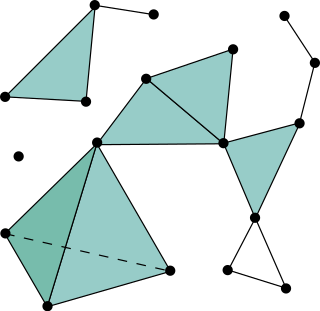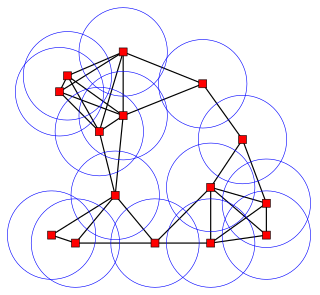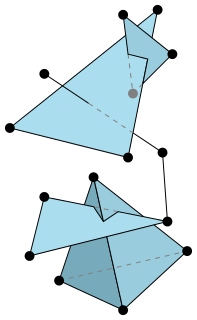In the mathematical field of algebraic topology, the fundamental group is a mathematical group associated to any given pointed topological space that provides a way to determine when two paths, starting and ending at a fixed base point, can be continuously deformed into each other. It records information about the basic shape, or holes, of the topological space. The fundamental group is the first and simplest homotopy group. The fundamental group is a topological invariant: homeomorphic topological spaces have the same fundamental group.

Algebraic topology is a branch of mathematics that uses tools from abstract algebra to study topological spaces. The basic goal is to find algebraic invariants that classify topological spaces up to homeomorphism, though usually most classify up to homotopy equivalence.
In mathematics, homology is a general way of associating a sequence of algebraic objects such as abelian groups or modules to other mathematical objects such as topological spaces. Homology groups were originally defined in algebraic topology. Similar constructions are available in a wide variety of other contexts, such as abstract algebra, groups, Lie algebras, Galois theory, and algebraic geometry.

In mathematics, a simplicial complex is a set composed of points, line segments, triangles, and their n-dimensional counterparts. Simplicial complexes should not be confused with the more abstract notion of a simplicial set appearing in modern simplicial homotopy theory. The purely combinatorial counterpart to a simplicial complex is an abstract simplicial complex.
In mathematics, a building is a combinatorial and geometric structure which simultaneously generalizes certain aspects of flag manifolds, finite projective planes, and Riemannian symmetric spaces. Initially introduced by Jacques Tits as a means to understand the structure of exceptional groups of Lie type, the theory has also been used to study the geometry and topology of homogeneous spaces of p-adic Lie groups and their discrete subgroups of symmetries, in the same way that trees have been used to study free groups.

Discrete geometry and combinatorial geometry are branches of geometry that study combinatorial properties and constructive methods of discrete geometric objects. Most questions in discrete geometry involve finite or discrete sets of basic geometric objects, such as points, lines, planes, circles, spheres, polygons, and so forth. The subject focuses on the combinatorial properties of these objects, such as how they intersect one another, or how they may be arranged to cover a larger object.

In mathematics, an abstract simplicial complex is a purely combinatorial description of the geometric notion of a simplicial complex, consisting of a family of non-empty finite sets closed under the operation of taking non-empty subsets. In the context of matroids and greedoids, abstract simplicial complexes are also called independence systems.
In mathematics, a simplicial set is an object made up of "simplices" in a specific way. Simplicial sets are higher-dimensional generalizations of directed graphs, partially ordered sets and categories. Formally, a simplicial set may be defined as a contravariant functor from the simplex category to the category of sets. Simplicial sets were introduced in 1950 by Samuel Eilenberg and J. A. Zilber.
In mathematics, particularly in homotopy theory, a model category is a category with distinguished classes of morphisms ('arrows') called 'weak equivalences', 'fibrations' and 'cofibrations'. These abstract from a conventional homotopy category of topological spaces or of chain complexes, via the acyclic model theorem. The concept was introduced by Daniel G. Quillen (1967).

In mathematics, particularly in algebraic topology, the n-skeleton of a topological space X presented as a simplicial complex refers to the subspace Xn that is the union of the simplices of X of dimensions m ≤ n. In other words, given an inductive definition of a complex, the n-skeleton is obtained by stopping at the n-th step.
In mathematics, higher category theory is the part of category theory at a higher order, which means that some equalities are replaced by explicit arrows in order to be able to explicitly study the structure behind those equalities. Higher category theory is often applied in algebraic topology, where one studies algebraic invariants of spaces, such as their fundamental weak ∞-groupoid.
Combinatorial commutative algebra is a relatively new, rapidly developing mathematical discipline. As the name implies, it lies at the intersection of two more established fields, commutative algebra and combinatorics, and frequently uses methods of one to address problems arising in the other. Less obviously, polyhedral geometry plays a significant role.
In algebraic geometry and algebraic topology, branches of mathematics, A1homotopy theory is a way to apply the techniques of algebraic topology, specifically homotopy, to algebraic varieties and, more generally, to schemes. The theory is due to Fabien Morel and Vladimir Voevodsky. The underlying idea is that it should be possible to develop a purely algebraic approach to homotopy theory by replacing the unit interval [0, 1], which is not an algebraic variety, with the affine line A1, which is. The theory requires a substantial amount of technique to set up, but has spectacular applications such as Voevodsky's construction of the derived category of mixed motives and the proof of the Milnor and Bloch-Kato conjectures.
In mathematics, a Stanley–Reisner ring, or face ring, is a quotient of a polynomial algebra over a field by a square-free monomial ideal. Such ideals are described more geometrically in terms of finite simplicial complexes. The Stanley–Reisner ring construction is a basic tool within algebraic combinatorics and combinatorial commutative algebra. Its properties were investigated by Richard Stanley, Melvin Hochster, and Gerald Reisner in the early 1970s.
In the mathematical discipline of simplicial homology theory, a simplicial map is a map between simplicial complexes with the property that the images of the vertices of a simplex always span a simplex. Note that this implies that vertices have vertices for images.
In mathematics, more precisely, in the theory of simplicial sets, a simplicial group is a simplicial object in the category of groups. Similarly, a simplicial abelian group is a simplicial object in the category of abelian groups. A simplicial group is a Kan complex The Dold–Kan correspondence says that a simplicial abelian group may be identified with a chain complex.
In algebra, a simplicial commutative ring is a commutative monoid in the category of simplicial abelian groups, or, equivalently, a simplicial object in the category of commutative rings. If A is a simplicial commutative ring, then it can be shown that is a commutative ring and are modules over that ring





